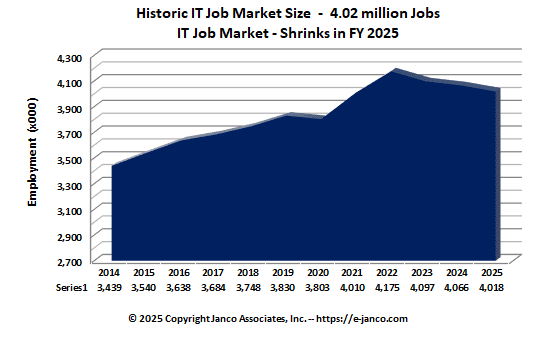2010 IT Employment Analysis and a Look Toward 2011 
- A CNN survey states that 84% of American workers are dissatisfied with their current jobs and are looking to make a change.
- Scared to take vacations and sick days, 44% of workers go to work ill.
- Business Insider Survey results point to 50% of respondents leaving a job before finding another opportunity due to job dissatisfaction.
- IT employment grew from 2009 to 2010 by only .17%
- 2011 should see a 10% to 20% IT hiring increase.
Analysis
I have written several articles over the last few months regarding the issues I see with the information technology job market going forward. I have taken a cautious tone with the employment picture and believe that we have at least two more years of slow to almost no growth in the IT.
 Let's pull back a bit and look at the job market as a whole to get a bit more perspective. One article on CNN states that 84% of American workers are chomping at the bit to leave their current position. This not really all that surprising considering how stretched the labor force is in corporate America. Long hours, stagnant wages, less benefits, and the constant fear of losing your job has taken a heavy toll. One can see this quite clearly if you are working within multiple organizations as a consultant. Most employees are frightened to take vacations or sick days, since they believe that will mark them as just another expendable resource, easily replaced by one of the many out of work.
Let's pull back a bit and look at the job market as a whole to get a bit more perspective. One article on CNN states that 84% of American workers are chomping at the bit to leave their current position. This not really all that surprising considering how stretched the labor force is in corporate America. Long hours, stagnant wages, less benefits, and the constant fear of losing your job has taken a heavy toll. One can see this quite clearly if you are working within multiple organizations as a consultant. Most employees are frightened to take vacations or sick days, since they believe that will mark them as just another expendable resource, easily replaced by one of the many out of work.
Historic IT Job Market Size
Updated with current data
For current data go IT Job Market Size to see the historic job market growth trend detail data
Subscribe to our Newsletter to get this information delivered to your inbox as soon as it is released. SUBSCRIBE
If you dive a bit further into that 84%, you will find that many of these employees have become "disengaged", perhaps as high as 50%. These disengaged individuals have mentally checked out of work and are going through the motions just enough not to raise any flags. A subset of those disengaged are actively working to sabotage management initiatives and put others in a poor light. The trend of disengagement was excellently covered by Dr. Judith Bardwick in her book One Foot Out the Door; which was presciently released just before the Great Recession (2007).
Of course, according to one survey featured in Business Insider, employees are not even lining up another gig before they pull the plug on their current job. A sampling of 225 adults showed that over 50% of them had just up and quit during the last two years due to dissatisfaction with the employer. This goes directly against the conventional wisdom of having a job before looking for another. In this job market a move like that either highlights dramatic workplace dissatisfaction or individuals who have other resources to tap into for income. That or they are naive about their job prospects.
Speaking about job prospects, 2010 was a pretty miserable time to be an IT professional looking for work. A Janco Associates study, provided by eWeek, showed only a .17% job growth from 2009 to 2010. Some IT disciplines, like data processing and telecommunications lost ground with 1 and 2 percent decreases in job opportunities. Also the Janco report points to the lack of entry-level IT jobs due to outsourcing, which is putting further pressure on the IT job market.
So tightening our job market focus a bit, let's look at IT in first quarter 2011. According to a December 2010 Dice report, IT hiring will enjoy a 10% to 20% bump. This will be focused in a few key areas, Development (Java, .Net), Infrastructure (SAP, Business Intelligence, Security) and Project Management. This data corroborated by a recently released Technisource's IT HIRE Intelligence survey, also summarized by eWeek.
IT compensation is still either flat or down based on 2009 data. However both the Dice and Janco Associates studies point to increased compensation in 2011. This is based on the employers having difficulty in finding and retaining necessary skill sets for their business, i.e. market pressure.



